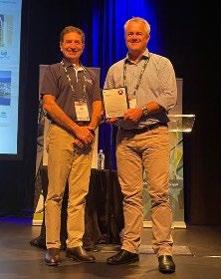CENTRAL QUEENSLAND
EMERALD AIRPORT RUNWAY, REHABILITATION AND OVERLAY PROJECT CENTRAL HIGHLANDS REGIONAL COUNCIL
Kerry Hayes Mayor of Central Highlands
The rehabilitation of a Central Queensland airport runway with ungrooved stone mastic asphalt is an award winning Australian-first project that became a valuable casestudy in innovation and collaborative management. Emerald Airport is the 34th largest airport in Australia. Owned and operated by the Central Highlands Regional Council, this airport on the edge of outback Queensland, transports approximately 208,000 passengers per year and services the main business hub of Emerald and the Bowen Basin coal region. The Queensland Government’s planning policy regards Emerald Airport as a strategic airport with a pivotal role in facilitating the state’s economic growth. The airport provides for a broad range of industries such as agriculture, business, tourism, recreation, health services (including the Royal Flying Doctor Service and Angel Flight) and regular passenger transport
58
The ridges between these grooves should be at least half (or more) of the pen’s height.
flights serviced by Qantas and Virgin Australia. Emerald Airport is a securitycontrolled airport overseen by the Department of Home Affairs. It is also a certified airport, meaning that it must comply with all aviation safety requirements, similar to much larger airports. Airport infrastructure investment could be described as ‘lumpy’; extended periods of routine maintenance are displaced by short periods of significant investment. The Emerald Airport Runway – Rehabilitation and Overlay Project was commissioned after visual condition inspections, deflection testing, ground investigations, preliminary geometry review and technical
analysis outcomes found the runway was several years past requiring attention. The usual average runway life span is approximately 12 to 15 years. The historic 20 to 30-year life span is rare now because of the refinement of materials and stricter aviation safety regulations. Built on black and reactive clay soils, the runway had deteriorated in several ways: oxidisation and deformations, wearing course and grooving erosion. It was uncommon to move from one groove floor to the next without encountering a height change. Early rehabilitation efforts focused on the runway ends that showed significant failures.
ENGINEERING FOR PUBLIC WORKS | MARCH 2021



























